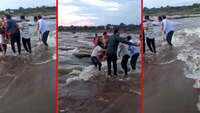
Coimbatore: For close to two decades, public and activists have been demanding the government bodies to take necessary steps to control the increasing pollution level in the Bhavani river, from where water is drawn for potable purposes in the district and neighbouring Tirupur, but to no avail.
The Tamil Nadu Electricity Board in Erode had set up two barrages - one at Samayapuram and the other at Omapalayam – to generate electricity in 2001. While drinking water for Tirupur and Mettupalayam areas is drawn near the first barrage, that for Avinashi, Annur, Sulur and Sirumugai is collected near the second barrage.
According to activists, the municipality is letting waste into the river between the two barrages.
T T Rangasamy, president, Bhavani River Water and Groundwater Protection Committee, said, “We have been protesting to draw the government’s attention to the issue for the past 25 years. The Tamil Nadu Agriculture University (TNAU) had in 2015 and the Tamil Nadu Water and Drainage Board (TWAD) in 2016 said the river water was polluted and unfit for consumption. In spite of that, nothing has changed on the ground. On the contrary, pollution levels have gone up.”
D Satheesh Kumar, former chairman of Mettupalayam municipality, said one of the steps that the state government had taken to prevent sewage water from entering the river was implementation of underground drainage (UGD) project in the municipality area. “While the municipality has completed about 80% of work, it is yet to start giving household connections. Since it’s an undulating area, it would be extremely difficult for sewage water to reach the treatment plant, unless it is designed and constructed properly. Even if the UGD project is completed, the success rate of reducing pollution level in the river is less.”
R Shanthamurthy, one of the trustees of Save Bhavani Trust, blamed the government for its failure to prevent industrial effluents from entering the river. “Whenever we file a complaint with the pollution control board, officials would inspect the industrial units. After a few days, they will start discharging effluents in the river.”
The Tamil Nadu Electricity Board in Erode had set up two barrages - one at Samayapuram and the other at Omapalayam – to generate electricity in 2001. While drinking water for Tirupur and Mettupalayam areas is drawn near the first barrage, that for Avinashi, Annur, Sulur and Sirumugai is collected near the second barrage.
According to activists, the municipality is letting waste into the river between the two barrages.
T T Rangasamy, president, Bhavani River Water and Groundwater Protection Committee, said, “We have been protesting to draw the government’s attention to the issue for the past 25 years. The Tamil Nadu Agriculture University (TNAU) had in 2015 and the Tamil Nadu Water and Drainage Board (TWAD) in 2016 said the river water was polluted and unfit for consumption. In spite of that, nothing has changed on the ground. On the contrary, pollution levels have gone up.”
D Satheesh Kumar, former chairman of Mettupalayam municipality, said one of the steps that the state government had taken to prevent sewage water from entering the river was implementation of underground drainage (UGD) project in the municipality area. “While the municipality has completed about 80% of work, it is yet to start giving household connections. Since it’s an undulating area, it would be extremely difficult for sewage water to reach the treatment plant, unless it is designed and constructed properly. Even if the UGD project is completed, the success rate of reducing pollution level in the river is less.”
R Shanthamurthy, one of the trustees of Save Bhavani Trust, blamed the government for its failure to prevent industrial effluents from entering the river. “Whenever we file a complaint with the pollution control board, officials would inspect the industrial units. After a few days, they will start discharging effluents in the river.”
Quick Links
Kerala Coronavirus Helpline NumberHaryana Coronavirus Helpline NumberUP Coronavirus Helpline NumberBareilly NewsBhopal NewsCoronavirus in DelhiCoronavirus in HyderabadCoronavirus in IndiaCoronavirus symptomsCoronavirusRajasthan Coronavirus Helpline NumberAditya ThackerayShiv SenaFire in MumbaiAP Coronavirus Helpline NumberArvind KejriwalJammu Kashmir Coronavirus Helpline NumberSrinagar encounter
Get the app








